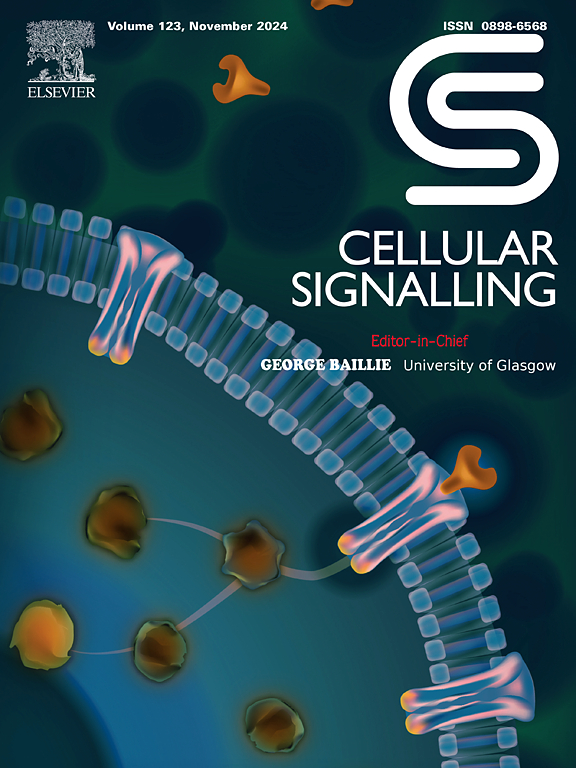HIF-1α c末端反活化结构域的激活通过己糖激酶2介导的代谢重编程促进小管间质纤维化。
IF 4.4
2区 生物学
Q2 CELL BIOLOGY
引用次数: 0
摘要
背景:低氧诱导因子-1α (HIF-1α)是低氧适应性反应的主要转录因子,具有两个转录激活域[TAD, n端(NTAD)和c端(CTAD)]。然而,HIF-1α CTAD在慢性肾脏疾病(CKD)中的确切作用尚不清楚。方法:本研究采用HIF-1α CTAD敲除(HIF-1α CTAD-/-)小鼠,建立缺氧性CKD小鼠模型,分别为缺血/再灌注性肾损伤和单侧输尿管梗阻性肾病。此外,己糖激酶2 (HK2)和糖酵解途径分别通过遗传和药物干预进行调节。结果:我们发现HIF-1α CTAD敲除可显著改善两种低氧诱导CKD模型的小管间质纤维化。此外,我们发现小管HIF-1α CTAD转录调节HK2,随后诱导促炎和纤维化小管表型。机制上,HIF-1α CTAD敲除导致的HK2缺乏通过抑制糖酵解改善了小管间质纤维化。在HIF-1α CTAD-/-小鼠中,HK2过表达通过诱导促炎和促纤维化小管表型显著促进小管间质纤维化。最后,用一种特定抑制剂抑制糖酵解可显著改善CKD小鼠的小管间质纤维化,减少促炎和纤维化小管表型。结论:HIF-1α CTAD的激活通过己糖激酶2介导的糖酵解促进缺氧诱导的小管间质纤维化。我们的研究结果表明HIF-1α CTAD-HK2通路代表了CKD中肾脏对缺氧反应的新机制,为缺氧诱导的CKD提供了一种有希望的治疗策略。本文章由计算机程序翻译,如有差异,请以英文原文为准。
Activation of HIF-1α C-terminal transactivation domain promotes tubulointerstitial fibrosis through hexokinase 2-mediated metabolic reprogramming
Background
The hypoxia-inducible factor-1α (HIF-1α), a master transcription factor for adaptive responses to hypoxia, possesses two transcriptional activation domains [TAD, N-terminal (NTAD) and C-terminal (CTAD)]. However, the exact effects of HIF-1α CTAD in chronic kidney disease (CKD) are poorly understood.
Methods
Here, two independent mouse models of hypoxia-induced CKD, including ischemia/reperfusion-induced kidney injury and unilateral ureteral obstruction-induced nephropathy, were established using HIF-1α CTAD knockout (HIF-1α CTAD−/−) mice. Further, hexokinase 2 (HK2) and glycolysis pathway were modulated using genetic and pharmacological interventions, respectively.
Results
We found that HIF-1α CTAD knockout significantly ameliorated tubulointerstitial fibrosis in two models of hypoxia-induced CKD. Further, we found that tubular HIF-1α CTAD transcriptionally regulated HK2 and subsequently induced proinflammatory and profibrotic tubule phenotype. Mechanistically, HK2 deficiency, which resulted from HIF-1α CTAD knockout, ameliorated tubulointerstitial fibrosis through inhibiting glycolysis. HK2 overexpression markedly promoted tubulointerstitial fibrosis by inducing proinflammatory and profibrotic tubule phenotype in HIF-1α CTAD−/− mice. Finally, glycolysis inhibition with a specific inhibitor significantly ameliorated tubulointerstitial fibrosis and reduced proinflammatory and profibrotic tubule phenotype in CKD mice.
Conclusions
Activation of HIF-1α CTAD promotes hypoxia-induced tubulointerstitial fibrosis through hexokinase 2-mediated glycolysis. Our findings suggested that the HIF-1α CTAD-HK2 pathway represents a novel mechanism of the kidney responses to hypoxia in CKD, providing a promising therapeutic strategy for hypoxia-induced CKD.
求助全文
通过发布文献求助,成功后即可免费获取论文全文。
去求助
来源期刊

Cellular signalling
生物-细胞生物学
CiteScore
8.40
自引率
0.00%
发文量
250
审稿时长
27 days
期刊介绍:
Cellular Signalling publishes original research describing fundamental and clinical findings on the mechanisms, actions and structural components of cellular signalling systems in vitro and in vivo.
Cellular Signalling aims at full length research papers defining signalling systems ranging from microorganisms to cells, tissues and higher organisms.
 求助内容:
求助内容: 应助结果提醒方式:
应助结果提醒方式:


